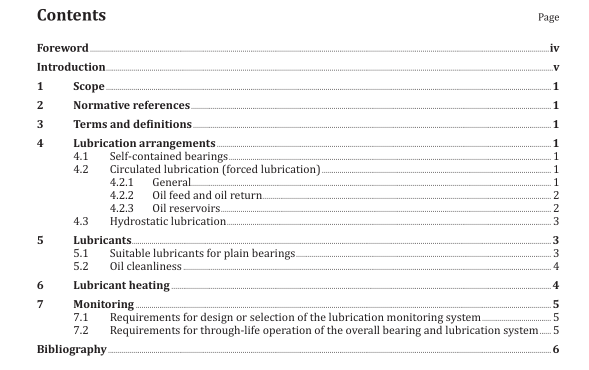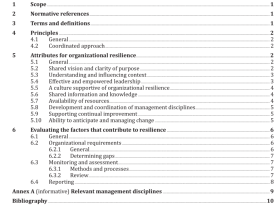ISO 19349 pdf download

ISO 19349 pdf download Plain bearings with liquid lubrication — Lubricant supply arrangements and monitoring
4.2.2 Oil feed and oil return
To minimize the possibility of vibrations or thermally induced tensile or compressive stresses occurring in the bearing housing, flexible compensators or connections shall be provided in the oil supply and drain piping systems if applicable. For electrically insulated plain bearings, it is necessary to consider whether oil supply and drain pipes connected to the bearing also need insulating to prevent short circuit of the bearing insulation. To restrict the pressure losses in the piping system to an economically justifiable amount, the oil mean flow velocity should not exceed 2 m/s in the supply lines according to experience.
The design of the return fluid flow path from the bearing to the oil reservoir shall be determined by the technical requirements of the bearing housing and the design requirements of the overall system installation. When the return flow is driven by gravity, oil return lines shall have a slope of at least 5 %. According to ISO 10438-1, oil drains shall be sized to run no more than half full when flowing at normal drain operating temperature at maximum flow conditions and shall be arranged to ensure good drainage (recognizing the possibility of foaming conditions). Junctions and changes in the direction of pipes shall be designed so as not to impair lubricant flow. Sharp bends and down or up loops shall be avoided. Junctions in return pipes shall be located in the direction of flow. In order to prevent foaming, vertical slopes exceeding 1 m in length shall be avoided. No devices significantly impeding the flow in the return line, such as filters, etc. shall be installed. Where more than one device (bearings, and possibly other consumers) is to be supplied with lubrication oil, the design of the oil supply and circulation system should mitigate against the potential harmful interactions in the return lines and oil reservoir caused by differential air pressure conditions.
4.2.3 Oil reservoirs The basic design requirements for oil reservoirs are given by ISO 4413 in conjunction with ISO 10438-1. Based on experience and with respect to air release and oil aging, the capacity of oil reservoirs should be approximately eight times the quantity delivered per minute. The factor eight may be reduced to three depending on the ratio of exposed surface area to volume in the oil reservoir, lubricant properties (air release additives), operating conditions, duty cycle and oil change interval. Small oil reservoirs in particular should have an internal weir or baffle plate between return and suction pipe to settle the returning oil and to permit entrained air in the oil to escape.
Oil reservoirs shall be suitably vented to allow entrained air to escape. In the – recommended – case of return pipes discharging below the reservoir oil level, vent holes shall be provided above the oil level so that the air in the reservoir is able to communicate with the air in the bearing housing via the partly filled return pipe. Oil reservoirs shall be equipped with an oil level indicator. The suction port of the outlet line shall be chamfered to reduce the inlet flow resistance and shall be situated low relative to the fluid level in order to minimize the foam content of the fluid drawn into the outlet line. In addition, the suction port shall be positioned a sufficient distance away from the bottom of the reservoir to prevent any deposits entering the device. The bottom of the oil reservoir shall have a slope towards the oil drain. The sloping floor of the reservoir acts to drive liquid contaminant (specifically, water) in the direction of the drain port, where it can be detected by sampling or removed.









